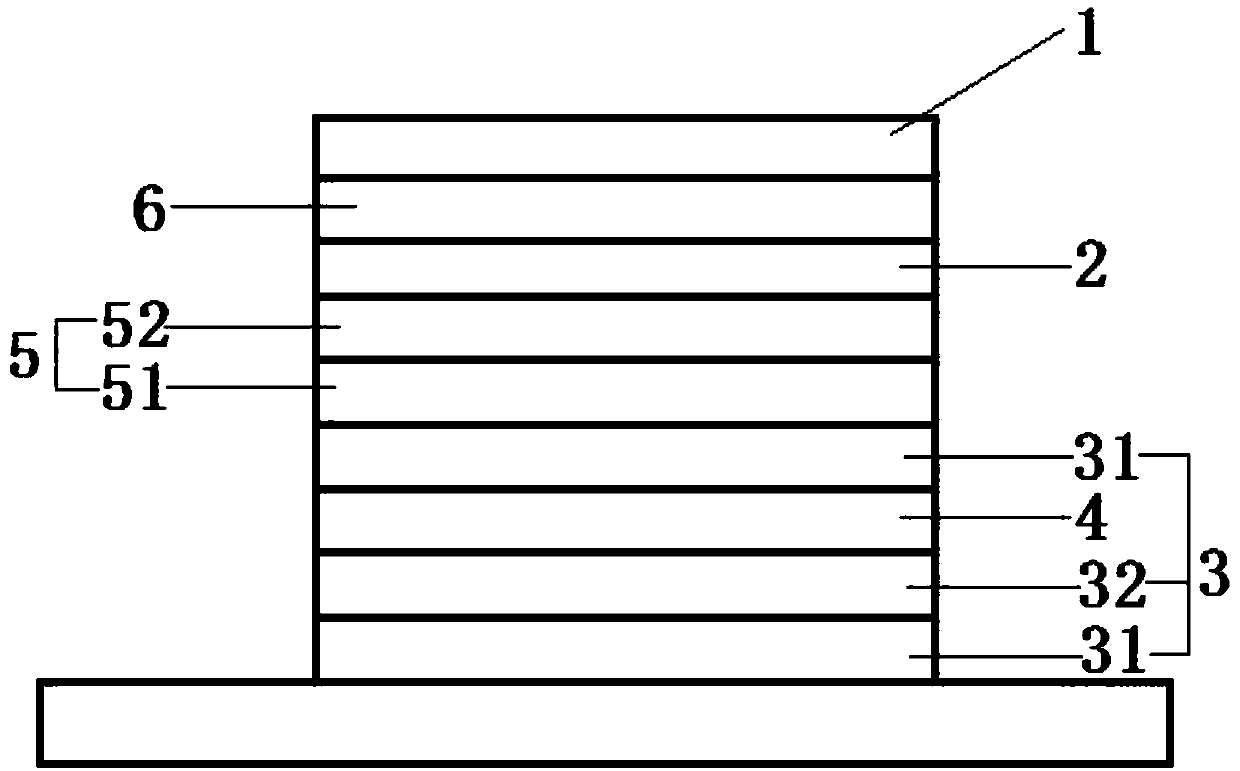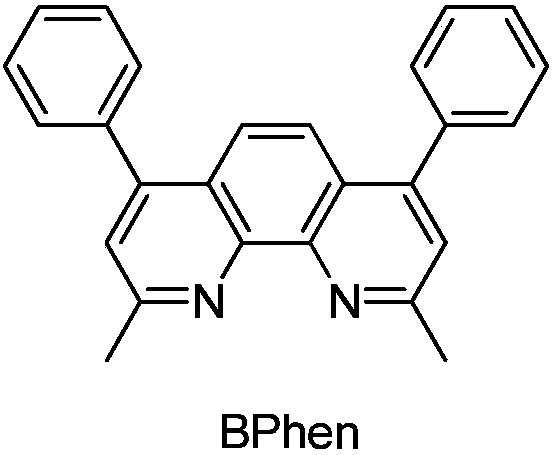An organic electroluminescent device
An electroluminescent device and luminescence technology, which is applied in the direction of electric solid-state devices, electrical components, semiconductor devices, etc., can solve the problems of low light extraction efficiency, achieve high luminous efficiency, high reflectivity, and improve the effect of light extraction efficiency
- Summary
- Abstract
- Description
- Claims
- Application Information
AI Technical Summary
Problems solved by technology
Method used
Image
Examples
Embodiment 1
[0050] This embodiment provides an organic electroluminescent device, such as figure 1 As shown, it includes a reflective electrode layer 1 , a second carrier functional layer 6 , a light emitting layer 2 , a first carrier functional layer 5 and a reflective electrode layer 3 which are stacked sequentially from top to bottom. Wherein, the reflective electrode layer 3 includes a reflective metal layer 32 and a transparent electrode layer 31, the Bragg reflector layer 4 is arranged on the upper surface of the reflective metal layer 32, and the upper surface of the Bragg reflector layer 4 and the lower surface of the reflective metal layer 32 are respectively A transparent electrode layer 31 is provided.
[0051] The reflective electrode layer 1 is a translucent cathode layer, which is an alloy layer formed by mixing Mg and Ag at a mass ratio of 9:1.
[0052] The second carrier functional layer 6 is an electron transport layer, and the electron transport layer material is select...
Embodiment 2
[0078] The present embodiment provides a kind of organic electroluminescent device, and the difference with the organic electroluminescent device in embodiment 1 is: the first mirror layer in the Bragg reflector layer 4 is SiNx (X gets 1-2) the thickness of SiNx d1=15nm, refractive index η1=1.9.
[0079] The above-mentioned organic light-emitting device complies with d*η=d1*η1+d2*η2+d3*η3+d4*η4+d5*η5=351 nm, therefore, the thickness d5 of the hole transport layer 52=(351-1.9*15- 1.5*50-2*20-1.9*5) / 1.9=104nm.
[0080] The organic electroluminescent device forms the following specific structure: ITO(20nm) / Ag(150nm) / SiNx (15nm) / SiO 2 (50nm) / ITO(20nm) / HAT(CN)6(5nm) / HTM081(104nm) / AND:5%B UBD-1(30nm) / Bphen(20nm) / Mg:Ag(9:1, 20nm) .
Embodiment 3
[0082] The present embodiment provides a kind of organic electroluminescent device, and the difference with the organic electroluminescent device in embodiment 1 is: the first mirror layer in the Bragg reflector layer 4 is SiNx (X gets 1-2) the thickness of SiNx d1=15nm, refractive index η1=1.9; the second mirror layer in the Bragg mirror layer 4 is TiO 2 ,TiO 2 The thickness d2=50nm, the refractive index η2=2.2.
[0083] The above-mentioned organic light-emitting device complies with d*η=d1*η1+d2*η2+d3*η3+d4*η4+d5*η5=351 nm, therefore, the thickness d5 of the hole transport layer 52=(351-1.9*15- 2.2*50-2*20-1.9*5) / 1.9=86nm.
[0084] The organic electroluminescent device forms the following specific structure: ITO(20nm) / Ag(150nm) / SiNx (15nm) / TiO 2 (50nm) / ITO(20nm) / HAT(CN)6(5nm) / HTM081(86nm) / AND:5%B UBD-1(30nm) / Bphen(20nm) / Mg:Ag(9:1, 20nm) .
PUM
 Login to View More
Login to View More Abstract
Description
Claims
Application Information
 Login to View More
Login to View More - R&D
- Intellectual Property
- Life Sciences
- Materials
- Tech Scout
- Unparalleled Data Quality
- Higher Quality Content
- 60% Fewer Hallucinations
Browse by: Latest US Patents, China's latest patents, Technical Efficacy Thesaurus, Application Domain, Technology Topic, Popular Technical Reports.
© 2025 PatSnap. All rights reserved.Legal|Privacy policy|Modern Slavery Act Transparency Statement|Sitemap|About US| Contact US: help@patsnap.com



